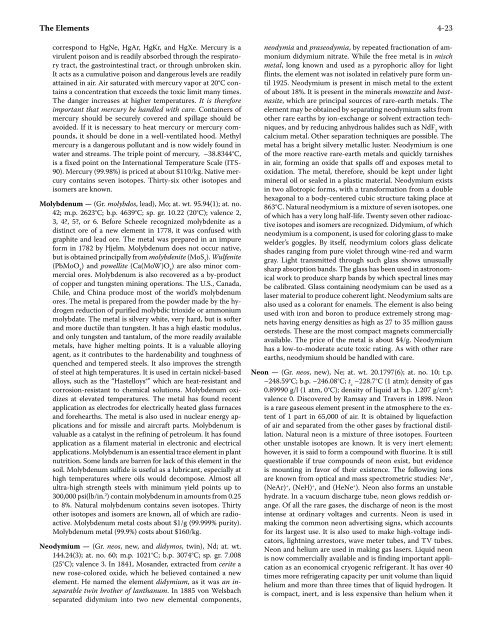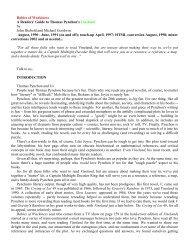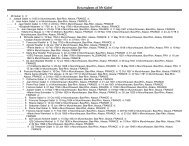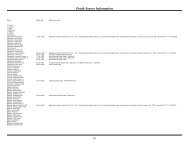CRC Handbook of Chemistry and Physics, 86th Edition
CRC Handbook of Chemistry and Physics, 86th Edition
CRC Handbook of Chemistry and Physics, 86th Edition
You also want an ePaper? Increase the reach of your titles
YUMPU automatically turns print PDFs into web optimized ePapers that Google loves.
The Elements 4-23<br />
correspond to HgNe, HgAr, HgKr, <strong>and</strong> HgXe. Mercury is a<br />
virulent poison <strong>and</strong> is readily absorbed through the respiratory<br />
tract, the gastrointestinal tract, or through unbroken skin.<br />
It acts as a cumulative poison <strong>and</strong> dangerous levels are readily<br />
attained in air. Air saturated with mercury vapor at 20°C contains<br />
a concentration that exceeds the toxic limit many times.<br />
The danger increases at higher temperatures. It is therefore<br />
important that mercury be h<strong>and</strong>led with care. Containers <strong>of</strong><br />
mercury should be securely covered <strong>and</strong> spillage should be<br />
avoided. If it is necessary to heat mercury or mercury compounds,<br />
it should be done in a well-ventilated hood. Methyl<br />
mercury is a dangerous pollutant <strong>and</strong> is now widely found in<br />
water <strong>and</strong> streams. The triple point <strong>of</strong> mercury, –38.8344°C,<br />
is a fixed point on the International Temperature Scale (ITS-<br />
90). Mercury (99.98%) is priced at about $110/kg. Native mercury<br />
contains seven isotopes. Thirty-six other isotopes <strong>and</strong><br />
isomers are known.<br />
Molybdenum — (Gr. molybdos, lead), Mo; at. wt. 95.94(1); at. no.<br />
42; m.p. 2623°C; b.p. 4639°C; sp. gr. 10.22 (20°C); valence 2,<br />
3, 4?, 5?, or 6. Before Scheele recognized molybdenite as a<br />
distinct ore <strong>of</strong> a new element in 1778, it was confused with<br />
graphite <strong>and</strong> lead ore. The metal was prepared in an impure<br />
form in 1782 by Hjelm. Molybdenum does not occur native,<br />
but is obtained principally from molybdenite (MoS 2 ). Wulfenite<br />
(PbMoO 4 ) <strong>and</strong> powellite (Ca(MoW)O 4 ) are also minor commercial<br />
ores. Molybdenum is also recovered as a by-product<br />
<strong>of</strong> copper <strong>and</strong> tungsten mining operations. The U.S., Canada,<br />
Chile, <strong>and</strong> China produce most <strong>of</strong> the world’s molybdenum<br />
ores. The metal is prepared from the powder made by the hydrogen<br />
reduction <strong>of</strong> purified molybdic trioxide or ammonium<br />
molybdate. The metal is silvery white, very hard, but is s<strong>of</strong>ter<br />
<strong>and</strong> more ductile than tungsten. It has a high elastic modulus,<br />
<strong>and</strong> only tungsten <strong>and</strong> tantalum, <strong>of</strong> the more readily available<br />
metals, have higher melting points. It is a valuable alloying<br />
agent, as it contributes to the hardenability <strong>and</strong> toughness <strong>of</strong><br />
quenched <strong>and</strong> tempered steels. It also improves the strength<br />
<strong>of</strong> steel at high temperatures. It is used in certain nickel-based<br />
alloys, such as the “Hastelloys®” which are heat-resistant <strong>and</strong><br />
corrosion-resistant to chemical solutions. Molybdenum oxidizes<br />
at elevated temperatures. The metal has found recent<br />
application as electrodes for electrically heated glass furnaces<br />
<strong>and</strong> forehearths. The metal is also used in nuclear energy applications<br />
<strong>and</strong> for missile <strong>and</strong> aircraft parts. Molybdenum is<br />
valuable as a catalyst in the refining <strong>of</strong> petroleum. It has found<br />
application as a filament material in electronic <strong>and</strong> electrical<br />
applications. Molybdenum is an essential trace element in plant<br />
nutrition. Some l<strong>and</strong>s are barren for lack <strong>of</strong> this element in the<br />
soil. Molybdenum sulfide is useful as a lubricant, especially at<br />
high temperatures where oils would decompose. Almost all<br />
ultra-high strength steels with minimum yield points up to<br />
300,000 psi(lb/in. 2 ) contain molybdenum in amounts from 0.25<br />
to 8%. Natural molybdenum contains seven isotopes. Thirty<br />
other isotopes <strong>and</strong> isomers are known, all <strong>of</strong> which are radioactive.<br />
Molybdenum metal costs about $1/g (99.999% purity).<br />
Molybdenum metal (99.9%) costs about $160/kg.<br />
Neodymium — (Gr. neos, new, <strong>and</strong> didymos, twin), Nd; at. wt.<br />
144.24(3); at. no. 60; m.p. 1021°C; b.p. 3074°C; sp. gr. 7.008<br />
(25°C); valence 3. In 1841, Mos<strong>and</strong>er, extracted from cerite a<br />
new rose-colored oxide, which he believed contained a new<br />
element. He named the element didymium, as it was an inseparable<br />
twin brother <strong>of</strong> lanthanum. In 1885 von Welsbach<br />
separated didymium into two new elemental components,<br />
neodymia <strong>and</strong> praseodymia, by repeated fractionation <strong>of</strong> ammonium<br />
didymium nitrate. While the free metal is in misch<br />
metal, long known <strong>and</strong> used as a pyrophoric alloy for light<br />
flints, the element was not isolated in relatively pure form until<br />
1925. Neodymium is present in misch metal to the extent<br />
<strong>of</strong> about 18%. It is present in the minerals monazite <strong>and</strong> bastnasite,<br />
which are principal sources <strong>of</strong> rare-earth metals. The<br />
element may be obtained by separating neodymium salts from<br />
other rare earths by ion-exchange or solvent extraction techniques,<br />
<strong>and</strong> by reducing anhydrous halides such as NdF 3 with<br />
calcium metal. Other separation techniques are possible. The<br />
metal has a bright silvery metallic luster. Neodymium is one<br />
<strong>of</strong> the more reactive rare-earth metals <strong>and</strong> quickly tarnishes<br />
in air, forming an oxide that spalls <strong>of</strong>f <strong>and</strong> exposes metal to<br />
oxidation. The metal, therefore, should be kept under light<br />
mineral oil or sealed in a plastic material. Neodymium exists<br />
in two allotropic forms, with a transformation from a double<br />
hexagonal to a body-centered cubic structure taking place at<br />
863°C. Natural neodymium is a mixture <strong>of</strong> seven isotopes, one<br />
<strong>of</strong> which has a very long half-life. Twenty seven other radioactive<br />
isotopes <strong>and</strong> isomers are recognized. Didymium, <strong>of</strong> which<br />
neodymium is a component, is used for coloring glass to make<br />
welder’s goggles. By itself, neodymium colors glass delicate<br />
shades ranging from pure violet through wine-red <strong>and</strong> warm<br />
gray. Light transmitted through such glass shows unusually<br />
sharp absorption b<strong>and</strong>s. The glass has been used in astronomical<br />
work to produce sharp b<strong>and</strong>s by which spectral lines may<br />
be calibrated. Glass containing neodymium can be used as a<br />
laser material to produce coherent light. Neodymium salts are<br />
also used as a colorant for enamels. The element is also being<br />
used with iron <strong>and</strong> boron to produce extremely strong magnets<br />
having energy densities as high as 27 to 35 million gauss<br />
oersteds. These are the most compact magnets commercially<br />
available. The price <strong>of</strong> the metal is about $4/g. Neodymium<br />
has a low-to-moderate acute toxic rating. As with other rare<br />
earths, neodymium should be h<strong>and</strong>led with care.<br />
Neon — (Gr. neos, new), Ne; at. wt. 20.1797(6); at. no. 10; t.p.<br />
–248.59°C; b.p. –246.08°C; t c –228.7°C (1 atm); density <strong>of</strong> gas<br />
0.89990 g/l (1 atm, 0°C); density <strong>of</strong> liquid at b.p. 1.207 g/cm 3 ;<br />
valence 0. Discovered by Ramsay <strong>and</strong> Travers in 1898. Neon<br />
is a rare gaseous element present in the atmosphere to the extent<br />
<strong>of</strong> 1 part in 65,000 <strong>of</strong> air. It is obtained by liquefaction<br />
<strong>of</strong> air <strong>and</strong> separated from the other gases by fractional distillation.<br />
Natural neon is a mixture <strong>of</strong> three isotopes. Fourteen<br />
other unstable isotopes are known. It is very inert element;<br />
however, it is said to form a compound with fluorine. It is still<br />
questionable if true compounds <strong>of</strong> neon exist, but evidence<br />
is mounting in favor <strong>of</strong> their existence. The following ions<br />
are known from optical <strong>and</strong> mass spectrometric studies: Ne + ,<br />
(NeAr) + , (NeH) + , <strong>and</strong> (HeNe + ). Neon also forms an unstable<br />
hydrate. In a vacuum discharge tube, neon glows reddish orange.<br />
Of all the rare gases, the discharge <strong>of</strong> neon is the most<br />
intense at ordinary voltages <strong>and</strong> currents. Neon is used in<br />
making the common neon advertising signs, which accounts<br />
for its largest use. It is also used to make high-voltage indicators,<br />
lightning arrestors, wave meter tubes, <strong>and</strong> TV tubes.<br />
Neon <strong>and</strong> helium are used in making gas lasers. Liquid neon<br />
is now commercially available <strong>and</strong> is finding important application<br />
as an economical cryogenic refrigerant. It has over 40<br />
times more refrigerating capacity per unit volume than liquid<br />
helium <strong>and</strong> more than three times that <strong>of</strong> liquid hydrogen. It<br />
is compact, inert, <strong>and</strong> is less expensive than helium when it







